When the mercury plunges and the trail vanishes beneath ice and snow, your boots become more than gear; they’re your lifeline. The best winter hiking boots lock in warmth, seal out slush, and claw into slick terrain so you can push on instead of turning back.
For over two decades, lead testers Chris Kassar and Ryan Kempfer have chased winter miles to see which boots actually deliver. This season, we upped the ante — lacing up 15 pairs and thrashing them through deep drifts, icy creek crossings, and frozen forest paths to find out what holds up when it matters most.
Whether you want the warmth and performance of our overall favorite, the KEEN Revel IV Polar, or the wallet-friendly reliability of our budget pick, the Columbia Bugaboot III, we have you covered. Inside you’ll find our top picks, in-depth impressions, and tips to help you choose the perfect pair for your own cold-weather adventures.
Editor’s Note: On October 31, 2025, we updated our Best Winter Hiking Boots guide with five new models, including three award-winners — the Merrell Moab Speed 2 Thermo Mid for its nimble, trail-ready feel; The North Face Chilkat 400 V for high-performance warmth and value; and the HOKA Kaha Frost GTX for unmatched cushioning and comfort on long winter hikes. We also refreshed all reviews after further testing and added detailed ratings to help you quickly compare models.
The Best Winter Hiking Boots of 2025-2026
Best Overall Winter Hiking Boots
9.3/10 Rating
Best Budget Winter Hiking Boots
8.2/10 Rating
Best Cushioned Winter Hiking Boots
8.7/10 Rating
Best Lightweight Winter Hiking Boots
8.5/10 Rating
Best High-Performance Value Winter Hiking Boots
8.9/10 Rating
See more picks
-
Extreme warmth: Mid rated to –25°F, High to –40°F -
Choice of mid or high shaft for mobility vs. deep snow -
Excellent grip on snow and ice -
Waterproof and breathable -
Pairs well with snowshoes and traction devices
-
Heavier and stiffer than lighter winter hikers -
Rigid sole feels clunky for casual wear
-
Super warm & comfortable -
Stellar traction -
Bomber weather protection & waterproofing -
Budget-friendly -
Capable hiker
-
Heavy and bulky -
Stiff fitting/lack of mobility -
Cumbersome to pull on and off
-
Warm, waterproof, and highly cushioned -
Smooth, rockered sole reduces fatigue -
True-to-size fit with roomy toe box and secure midfoot -
Excellent traction on snow and ice
-
Less warmth and protection than taller winter boots for deep snow or snowshoeing -
Bulky shape can make traction hard to use
-
One of the lightest winter boots we’ve tested -
Warm and waterproof -
Comfortable, true-to-size fit with room for thicker socks -
Excellent traction
-
Less warmth and protection than taller, heavy-duty winter boots -
Low-profile shape doesn’t pair well with crampons or snowshoes
-
Warm and waterproof for most winter conditions -
Comfortable, hiking-boot-like fit with soft lining -
Reliable traction on snow and ice -
Excellent overall performance at an affordable price
-
Some taller boots offer slightly more warmth & protection
More Winter Hiking Boots Built to Beat the Freeze
-
Warm and waterproof without full expedition bulk -
Flexible and responsive feel for faster hikes -
Aggressive outsole grips snow, ice, and frozen trails -
Women’s version (Hike) offers a streamlined fit
-
Snug fit; only offered in full sizes, so many size up -
Bulky for casual indoor wear
-
Extremely light for a winter hiking boot -
Zero-drop platform allows natural foot movement -
Removable heat-reflective insole boosts warmth -
Vegan-friendly construction
-
Requires careful lacing for best fit -
Less warmth and protection than heavier winter boots
-
Exceptionally light -
Feature rich -
VECTIV technology prioritizes momentum -
Packable
-
Not ideal for those with wide feet -
Extreme toe spring can cramp the toes
-
Slick side-zip makes for easy access while wearing thick layers -
Well-insulated with 200G PrimaLoft for winter hikes -
Vibram Arctic Grip outsole provides traction on ice -
Lightweight and low profile
-
More expensive than some winter hikers -
Not the most supportive or tall boot shaft
-
Multiple shaft heights (7” & 9” for women; 8” & 10” for men) -
Waterproof but breathable -
Supportive hiking-boot feel with aggressive outsole -
Warmer and more protective than most mid-height winter hikers
-
Heavier and bulkier than lighter winter boots -
Can feel narrow for wide feet
-
Warm, waterproof, and insulated -
Easy side-zip closure for gloved hands -
BOOST midsole reduces fatigue -
Athletic, sock-like fit
-
Less support than full alpine boots -
Unconventional closure may not appeal to all
-
Comfort -
Durability -
Superb braking lugs -
Outsole offers good grip -
Ankle movement isn’t restricted
-
Efficiency -
Agility -
Durable construction — holds up to miles and abrasions -
Accommodating fit -
Reliable grip on variable surfaces
-
Heavier than some competitors -
Questionable breathability -
Pricey -
Not the warmest
Winter Hiking Boots Comparison Chart
How We Tested the Best Winter Hiking Boots
Our Expert Testers
Slogging up slushy alpine slopes, trekking over muddy, root-strewn trails, or simply trotting around town — the GearJunkie team doesn’t mess around when testing hiking boots. We rifled through our closets, talked with veteran backpackers, and scoped the retail shelves to lace up with the best winter hiking boots around. You can rest assured that each boot on this list has been rigorously tested on real-world treks in the backcountry.
Staff authors Peter Reese and Mallory Paige — both seasoned outdoor enthusiasts — curated our initial roundup of 12 boots in February. Ever since, we have been testing new models and brands to bring you the streamlined selection you see today.
Over the last couple of years, Chris Kassar and Ryan Kempfer joined the testing team to help put new models through their paces. These stone-cold pros have vetted the boots on this list and put them through the wringer in demanding winter environments — all proving to be worthy.

Our Testing Grounds
Every boot in this guide earned its place through months of on-snow abuse. Lead testers Ryan Kempfer and Chris Kassar put each model through its paces on Colorado’s winter 14er summits, across frigid Yellowstone mornings while watching wolves, on easy dog-friendly hikes around Jackson, and during big snowshoe efforts deep into the Tetons. These varied conditions let us see how each boot handles steep ascents, icy descents, long miles in bitter cold, and more casual winter outings alike — the same range of adventures our readers tackle every season.


Our Testing Process
We put these boots through full-on winter abuse — not just a quick walk on a snowy sidewalk. Testing took place in deep alpine snow, on icy summits, and along groomed trails while hiking, snowshoeing, and sometimes post-holing for miles. We often carried multiple pairs on a single outing and swapped mid-trail to directly compare warmth, traction, and comfort in the same conditions.
Because every foot is different and every hiker has different goals, we gathered feedback from a wide range of contributors, editors, and friends of the publication. But as much as we value outside perspectives, we didn’t just take anyone’s word for it — we focused on true winter hiking boots designed for snow, ice, and frigid conditions rather than standard hiking boots with waterproof membranes. Each model was tested for comfort, weather protection, and durability, including standing in freezing water to make sure waterproofing held up to real-world submersion.
This is an organic, constantly evolving guide. We update it regularly with the top models on the market so you’re always seeing the most relevant, best-performing winter hiking boots available.
If you’re looking for all-season hiking boots, check out our guides to the best hiking boots for women and for men. And, if you’re looking for more casual winter boots, check out our guides to the best winter boots for men and best winter boots for women. And don’t forget to check out our guide to winter traction devices before heading outside this winter.
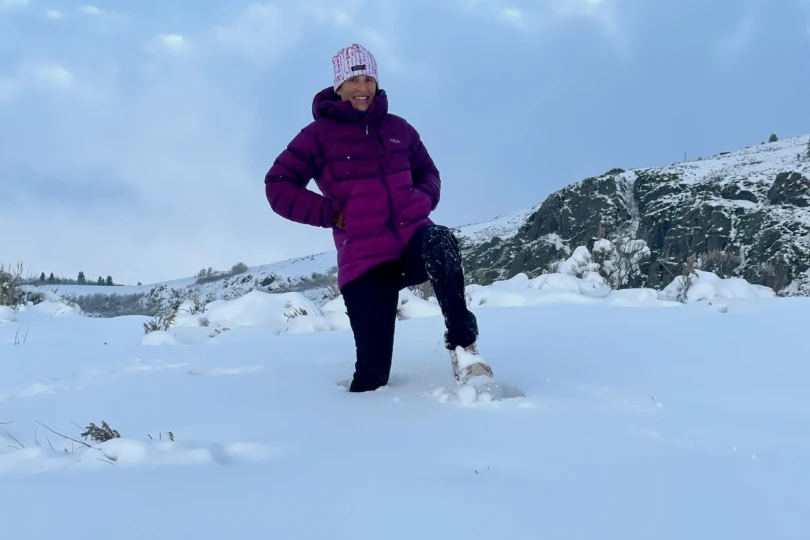



Our Winter Hiking Boots Rating System
Each boot in this guide is scored on a 1–10 scale, using decimals for precision. The overall score is our complete verdict based on real-world testing rather than a simple average. We evaluate warmth to see how well a boot keeps feet comfortable in subfreezing temperatures. Weather protection measures water resistance and how materials hold up in snow and slush. Comfort and fit gauge cushioning and support over long, cold miles. Traction tests grip and stability on packed snow, ice, and mixed winter terrain. Together, these scores give you a clear picture of where each boot excels and where it may fall short, so you can confidently pick the right pair for your adventures.
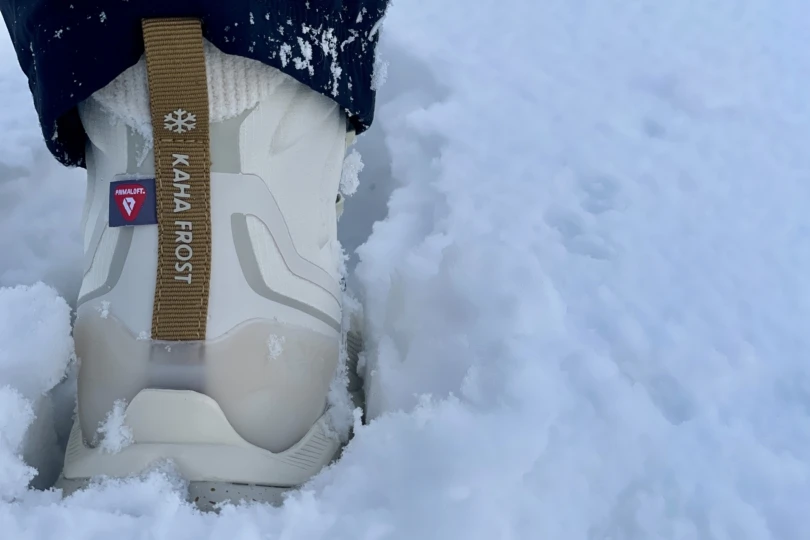



Buyer’s Guide: How to Choose the Best Winter Hiking Boots
Where Are You Hiking?
Winter means wildly different things depending on your location. So, before seeking out the perfect boot, take a moment to think about your location. Is it wet, snowy, or mostly dry?
Do you regularly see temps in the single digits? Or do you enjoy a milder winter average? Answering these questions will help you weigh the importance of waterproofing and insulation.
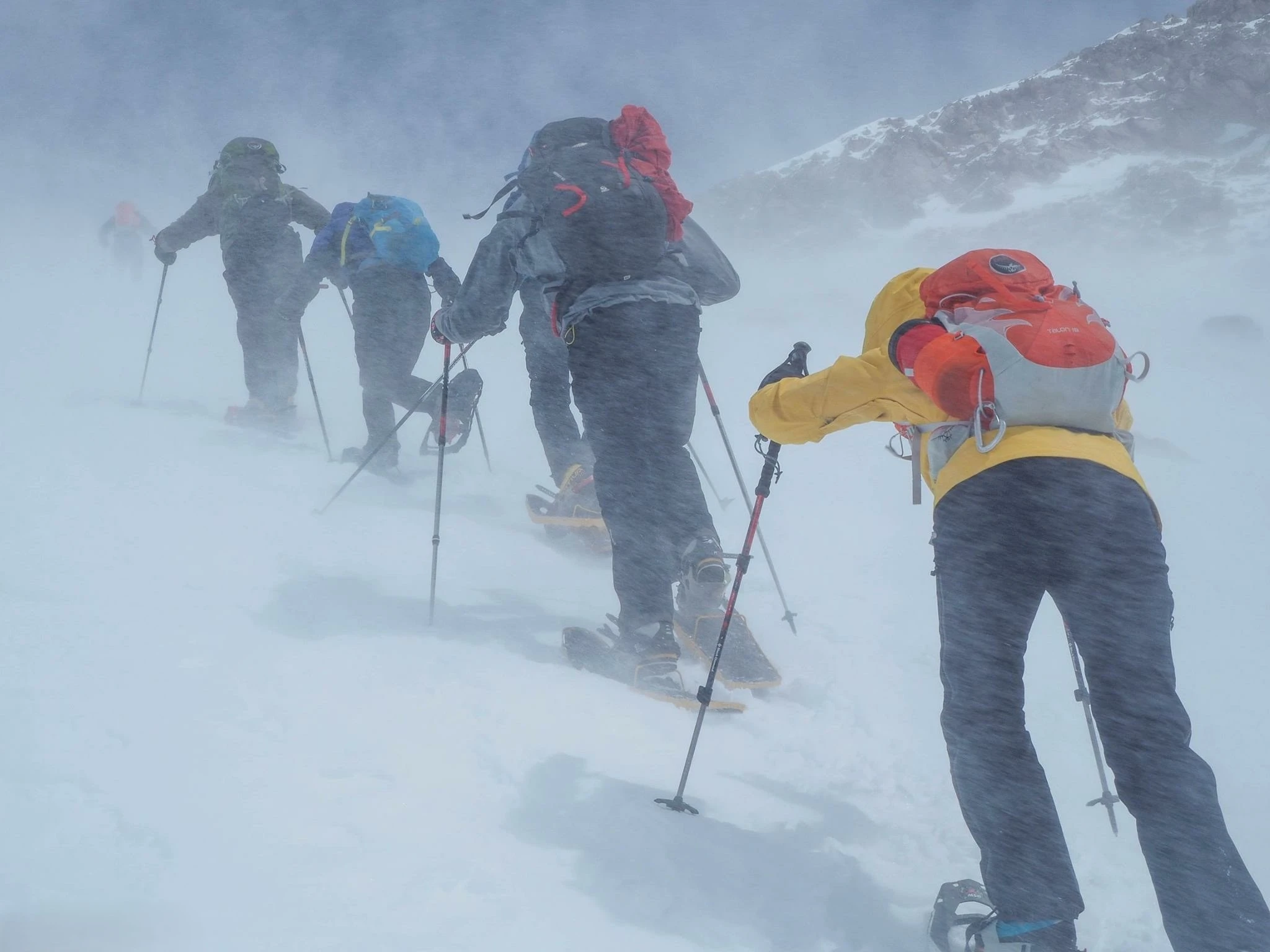



Warmth
The importance of warm feet can’t be argued. This goes beyond avoiding frostbite or cold damage to your feet and toes. Improperly insulated feet can both ruin a winter hiking experience and change a life, dramatics aside.
Targeting the right level of insulation and weather protection for each hiker — given their location and types of trips — is part of picking the right boots. For some, an insulated boot is the antidote to cold weather. Others thrive with merino wool socks inside their synthetic or leather boots.
Winter boots don’t have to include insulation to be considered for winter travel. Many people like the freedom of keeping their feet warm with thick socks in waterproof boots and put thinner socks on when the temperatures increase and they want more breathability. For those, our unsolicited but still waterproof picks, like the Salomon Cross Hike GTX, make good choices.
Others prefer thick, cozy insulation at all times when trudging around in frigid conditions — and may gravitate to models like the Columbia Bugaboot III. If your feet run cold or you hike long distances at high altitudes, the KEEN Revel IV is an awesome option that’s rated to -25 degrees F.




Waterproof Boots
Waterproofing fights back against water intrusion, being impervious to incoming moisture at any temperature. These models, like The North Face Chilkat, are particularly attuned to deep snow and temporary immersion in shallow standing or running water.
This puts water protection inside a more durable exterior layer of leather or fabric. As with resisting or repelling water, the boot’s tongue and lacing system are potential weak points in achieving a tight seal.
Caution is needed here, as allowing the foot to maintain a 60% humidity level during exertion is a balancing factor. Those who get hot, sweaty feet while walking benefit from the ability to release excess perspiration even during colder months, and even when it’s wet outside the boot itself.
Many, if not most, winter hiking boots identified as waterproof now have “breathable” as a critical caveat to accomplish this feat, incorporating GORE-TEX or similar tech to prevent water from entering the boot but allowing vapor to escape.
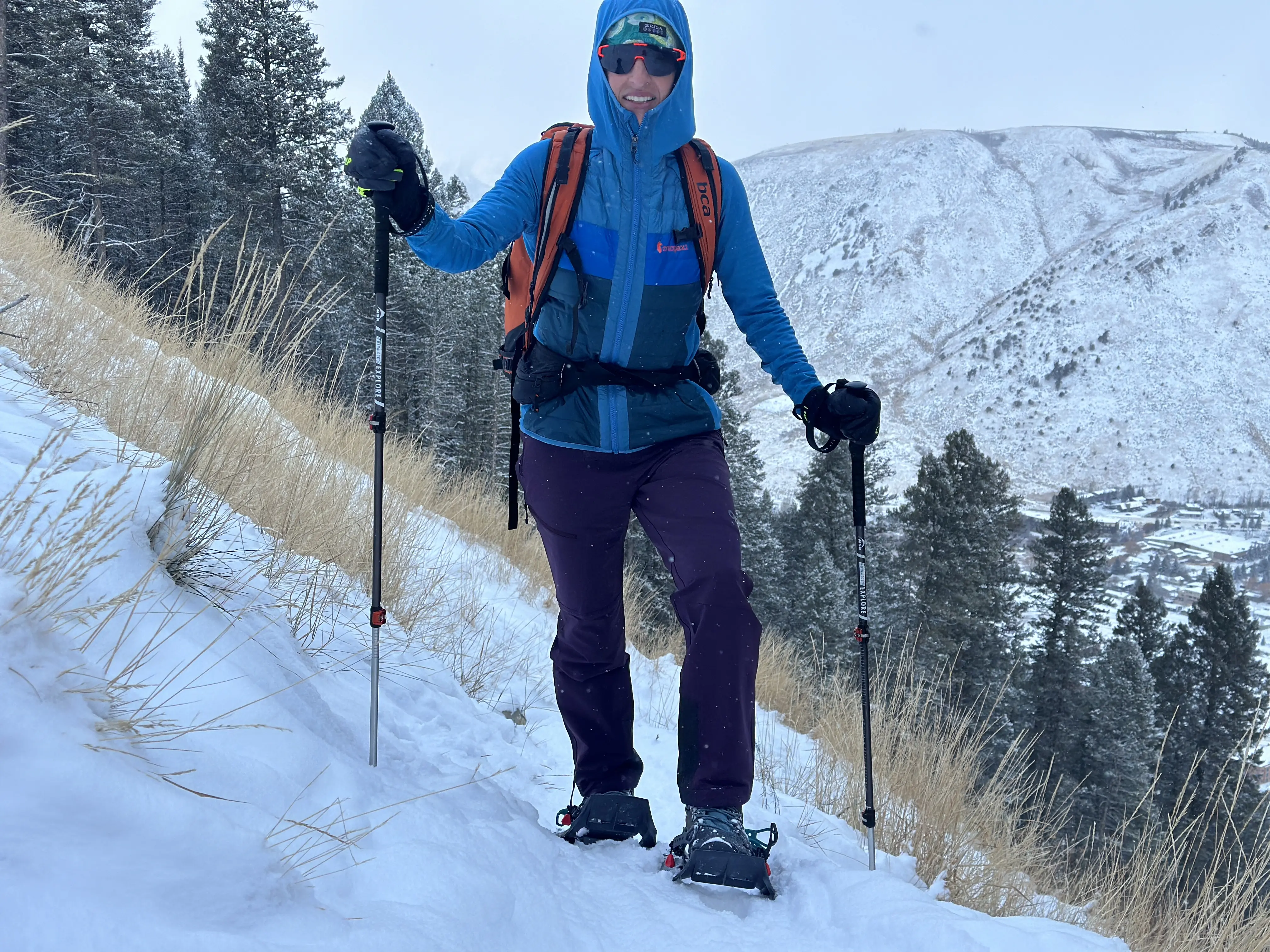



Insulation
Most winter hiking boots have some level of insulation. It’s measured in grams and generally ranges from 100 g to 600 g. Most of the boots included here, like our overall top pick, the KEEN Revel IV Mid Polar, are in the 100-200g range. We find that it offers the best warmth without overheating during active hiking. On the extreme end of that spectrum, yet remarkably breathable, The North Face Fastpack Vectiv sports 200g Heatseeker Eco insulation.




Comfort
Comfort, for the purposes of this guide, is defined as “supporting good blood circulation, moving easily across variable terrain, and allowing minor fit adjustment for sock and weather conditions.”
Being easy to put on and take off is also a plus. As with traction, the thickness and composition of the sole system have an effect on comfort. A thick and robust sole like we see in the Columbia Bugaboot III prevents sharp underfoot rocks from poking into the ever-sensitive bottom of the foot.
From initial fit to general comfort at rest and in motion, a smart boot pick comes with box-to-backcountry confidence every time the trail calls and laces get tied. Sore feet are a bummer, but fortunately, they’re completely avoidable. If you have wide feet, trending minimalist like the Xero Alpine Boots is a good idea since they offer wide toe boxes and flat soles for a more natural feel.
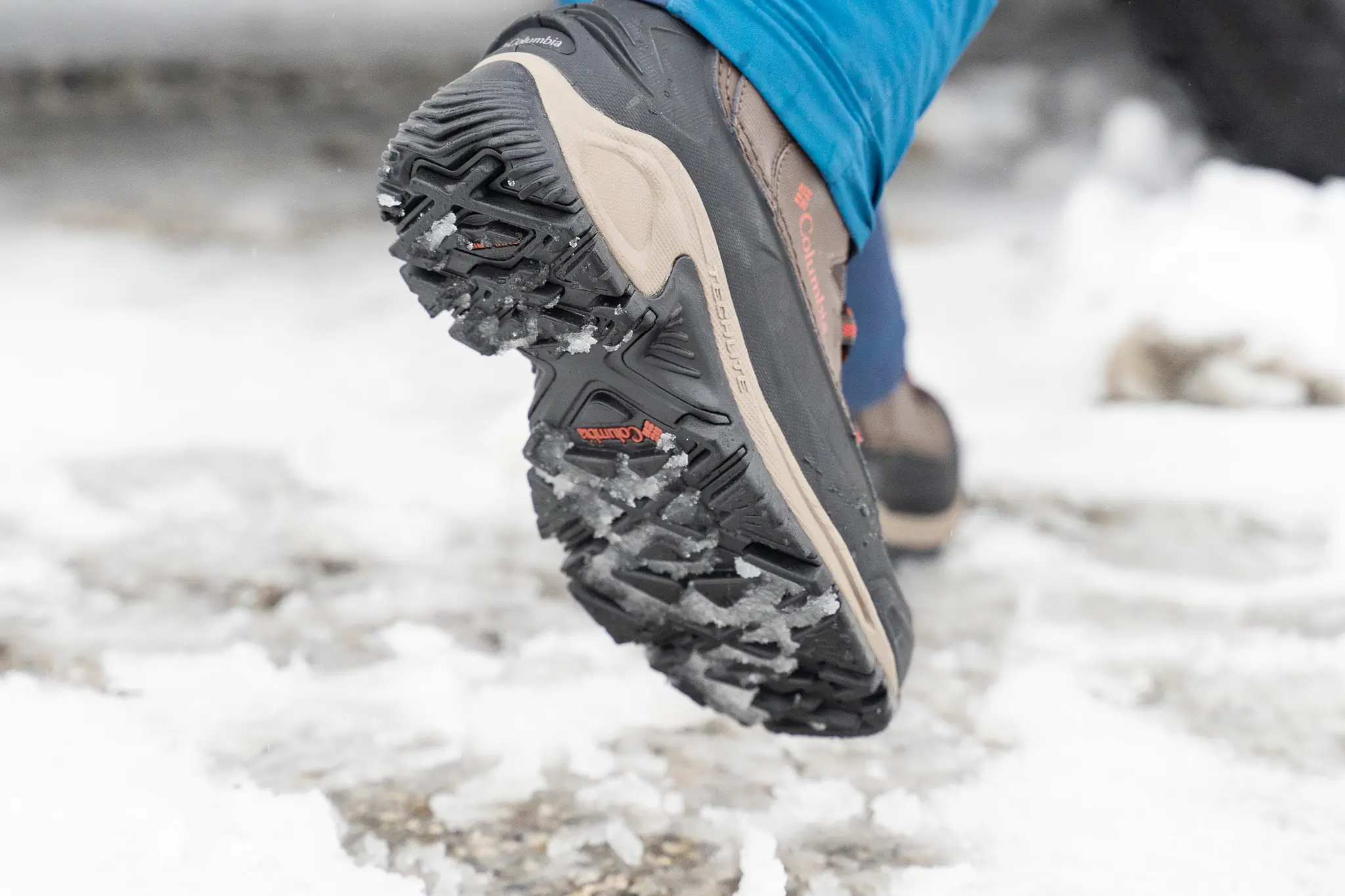



Traction
Winter boots like the Columbia Bugaboot III have a lug pattern designed for snow and ice. In addition, the rubber compounds used are made to stay soft and grippy in frigid conditions. This is adequate for many winter outings, even ones where ice, mud, snow, and dirt are prevalent. However, in extreme ice, we still reach for a traction device like those featured in our Best Winter Traction Devices guide.
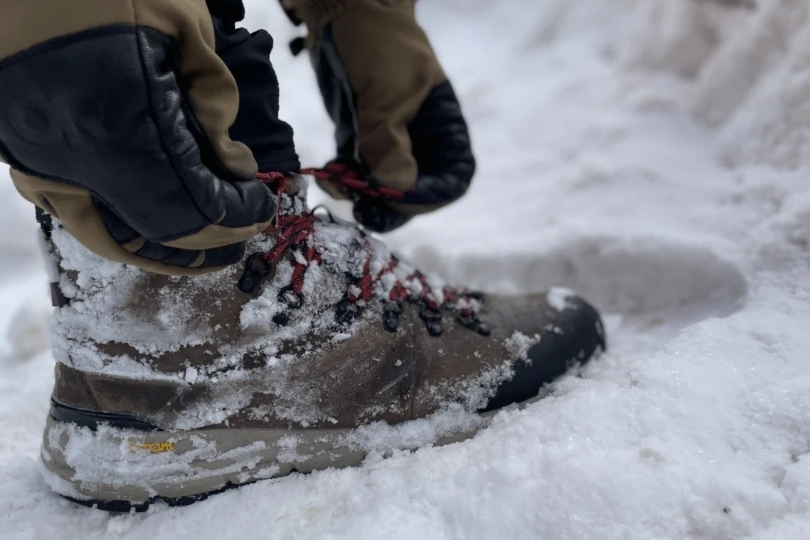



Durability
Winter boots are susceptible to wear-induced failure in at least three ways. First is in the closure or lacing system, where pulling to tighten the boot stresses the seams, including the tongue’s attachment.
Second is the cuff around the ankle, where simple wear can break down the collar or padding at the top of the upper. Third, the material on the toe; coarse snow can act like sandpaper to abrade the leading section of the boot. Often, as on a work boot, this toebox area is reinforced against scraping from the outside as well as repeated toe impact on the inside.
Keep in mind that the materials affect the durability. Leather boots may require more care upfront, but ultimately, it will last longer than the synthetic and textile options. But if you don’t take care of it, it may deteriorate sooner.
Durability can often come down to regular maintenance, and, above all, always drying your gear before storing. Especially important with snow and mud that are winter hiking mainstays.


Winter Hiking Gear
Along with a good winter boot, these pieces of gear will make cold, snowy outings that much more enjoyable.
Socks
Good winter hiking socks regulate temperature and humidity inside the boot, add comfort by cushioning the foot, and can improve the boot’s fit to some degree. Most winter hiking simply requires a single, midweight sock.
Insoles
Insoles (often called footbeds) have become more common in the last five years, as some manufacturers put thin factory inserts into boots as placeholders. For winter hiking, season-specific insoles add a modicum of insulation. Others also improve the mechanical support for the foot inside the boot. The cost of a merino or hybrid foam product ranges from $25 to $60 and lasts up to three years.
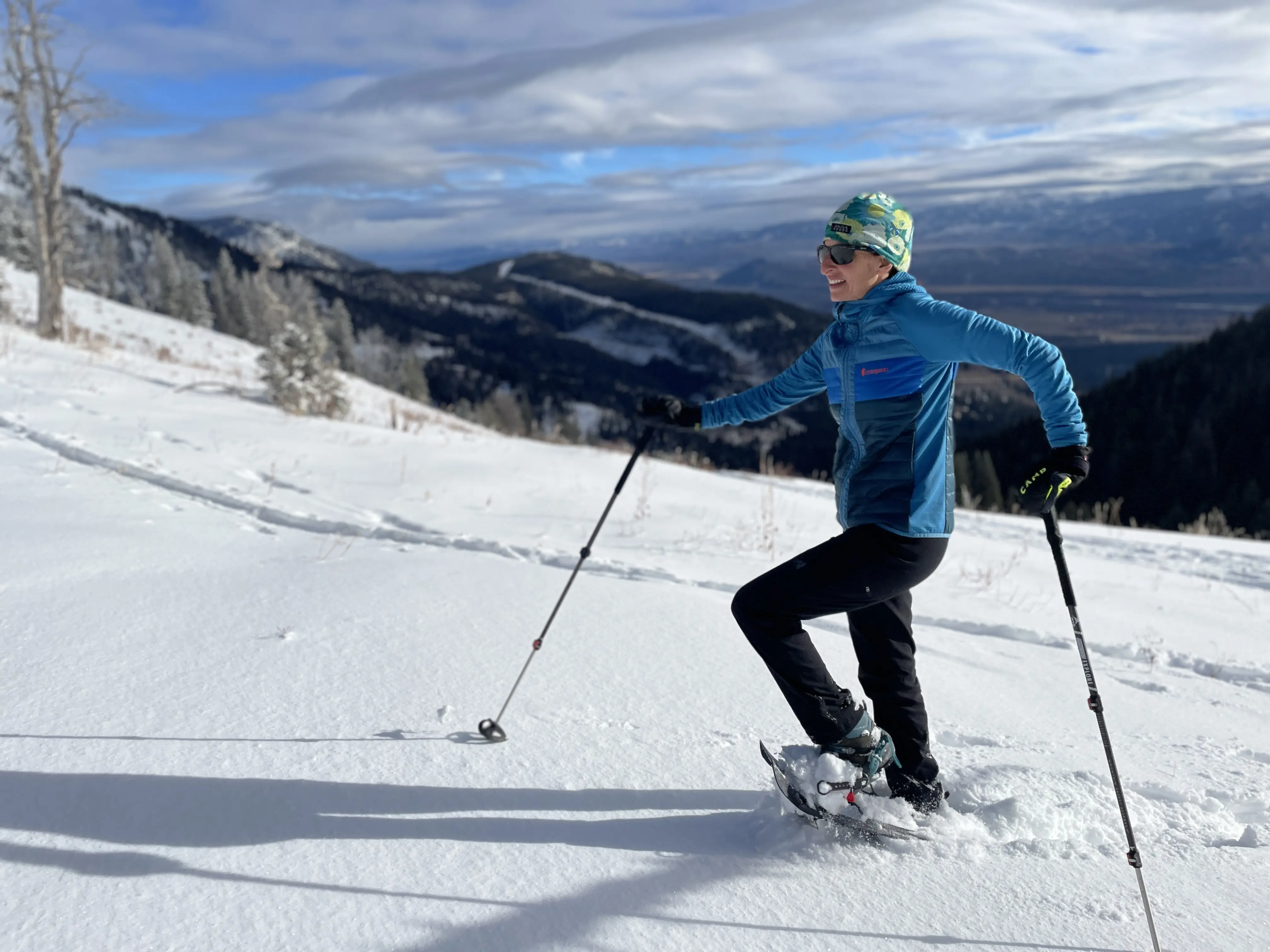



Traction Devices
These turn many boots into multitools that can competently move across slippery surfaces, crusted snow, and glazed ice. There are many options, and those with miniature cleats or crampons allow safer travel. Check out our guide to the best winter traction devices for a full discussion and list of our favorites.
These devices are convenient to carry, use, and then repack. Plan to spend between $40 and $120. Strong choices include the Kahtoola MICROspikes Traction System and the Korkers Ice Walker, both at about $70.
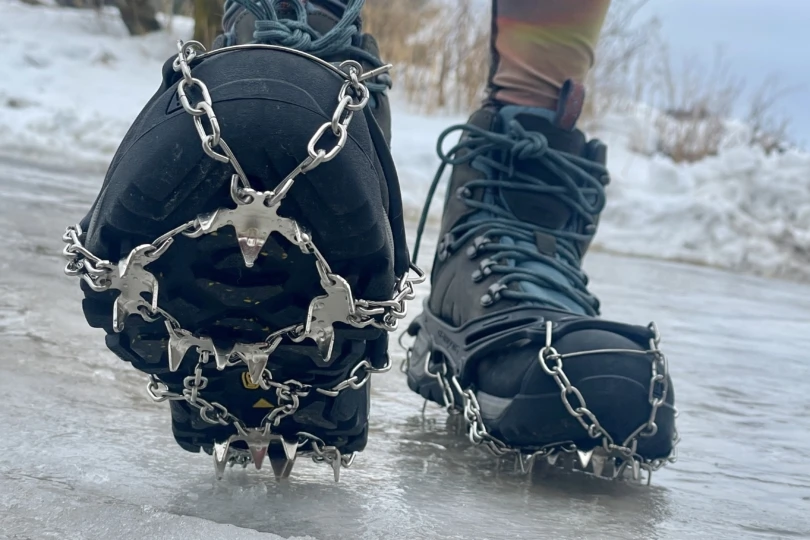



Gaiters
They are seen most often in mountaineering photos or those of old-time backcountry skiing. While the low versions are most helpful for keeping debris out of hiking and trail running shoes, the taller models help prevent deeper snow and harsh rains from working their way into the boot’s cuff.
With gaiters, only a few worthwhile, waterproof-breathable options exist, most in the $100-120 range. Classic and hard to beat are Outdoor Research Crocodile Gaiters that add only a few ounces, defy abrasion, and come in all sizes.
Trekking Poles
Trekking poles come with or without ski baskets that allow their use in snow accumulations over 5 inches. Most are collapsible to attach to a daypack and earn their keep on steeper slopes on slipperier surfaces, as well as when carrying a heavier payload.
Snowshoes
Like many of the other system components, snowshoes deserve serious consideration if deeper snow conditions are common or anticipated. Boots with stiffer soles are great candidates for use with binding-equipment snowshoes.




Price & Value
Boots built for hiking in cold, snowy, icy conditions inevitably cost more than some other, more casual types of footwear. However, in this category, price doesn’t always mean warmer or more waterproof, so be sure to choose the best winter hiking boots for your needs instead of just by price.
Budget
Solid budget winter hiking boots hold a minimum price tag of $100-170. If you opt for a lightweight design with moderate insulation and water resistance, you can grab a pair like the fashionable and functional Xero Alpine Boot ($160). However, these aren’t as supportive as others. Or, you can also snag our budget pick, the Columbia Bugaboot III ($120), which is insulated and waterproof but is a bit heavier and bulkier than some of our pricier picks.
Mid-Tier
Jumping up into the $180-210 price range brings higher overall quality and usually a bump in weatherproofing. Our top overall pick, the KEEN Revel IV Mid Polar ($180), is extremely warm, waterproof, and tough — it’s built to withstand extremes and offers unparalleled traction. The Oboz Bridger 7” Insulated ($210), has an incredible amount of warmth and traction, as well. As mentioned, a higher price doesn’t automatically mean warmer. The Merrell Moab Speed 2 Thermo ($190) offers great traction and comfort but isn’t as warm as others, so be sure to choose carefully for what you need.
Premium
The priciest winter hiking boots cost more than $230. Often, these boots have more technical features and greater warmth, traction, and waterproofing. However, as we mentioned earlier, this isn’t always the case. The versatile Lowa Renegade Evo GTX ($280) has many features, but believe it or not, it’s not insulated!
The Adidas Terrex Free Hiker 2 ($260) is completely waterproof and insulated, super supportive, and has nifty features like zippers that can be operated with gloves. Both of these options are durable and will last many seasons.
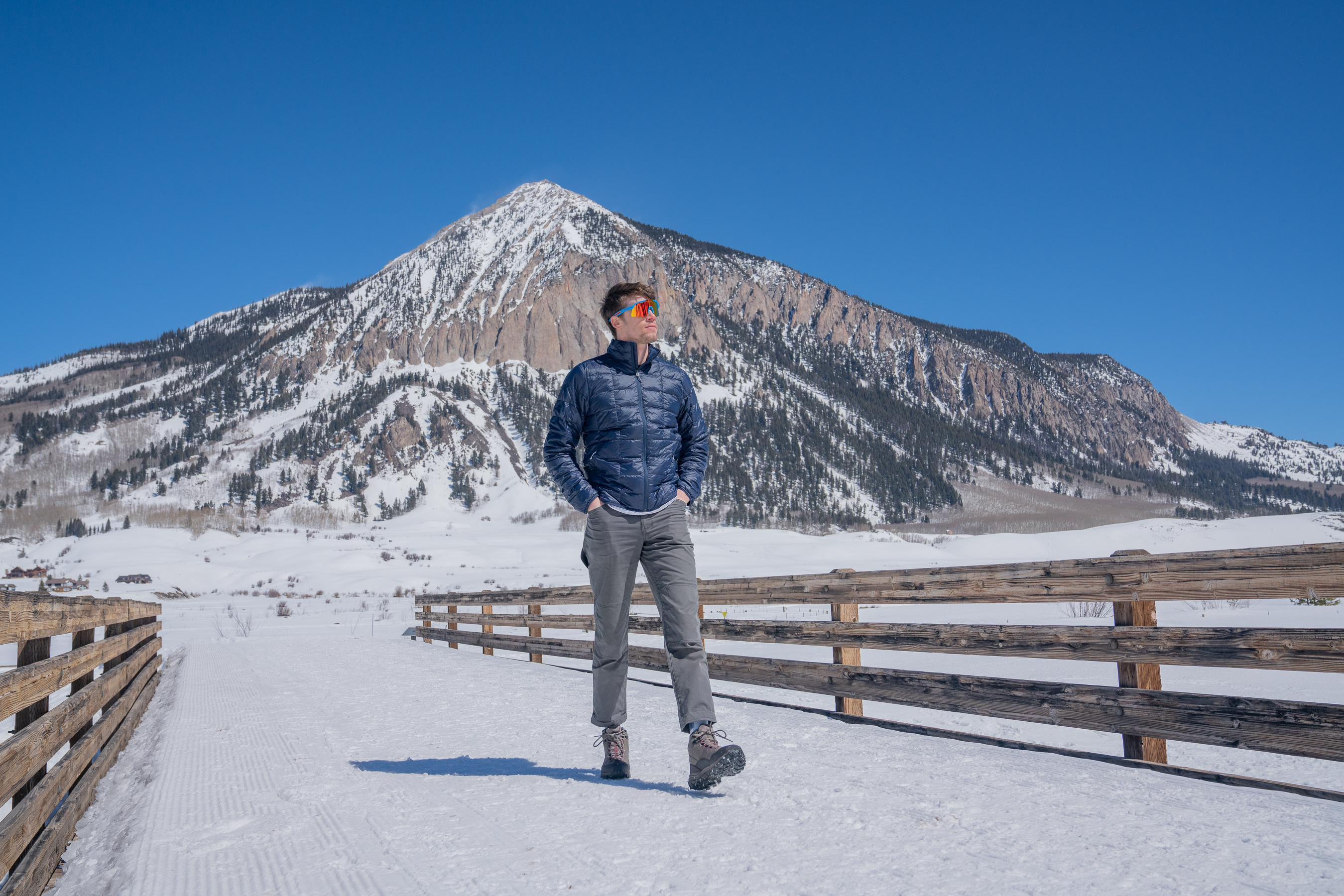

Frequently Asked Questions
While a winter hiking boot will work for all general winter activities, a general winter boot may not work for hiking. What’s best for running to the bus stop or shoveling snow may not hold up to extended miles on the trail or time in the backcountry. We tested these boots specifically for hiking applications, so you know you can trust them to perform when it counts.
Over 90% of the time, the answer is “no” as the manufacturers have accommodated a midweight hiking sock into their sizing calculations. When possible, we recommend heading to your local gear shop for a fitting. Bring along the socks you plan to use and any aftermarket insoles to find the most accurate fit.
The big concerns with winter boots are warmth, traction, and keeping snow out. And while all of the boots listed here can hold their own in these categories, there are a few standouts if your winter hikes are particularly snow- and ice-laden.
This really depends on the terrain, weather, and personal preference. Boots offer better ankle support and come in more insulated options. Hiking shoes are preferred by many for their light weight and improved maneuverability.
If your winter hiking entails lots of powder, it’s worth investing in a boot. If you live in a milder climate, a shoe can easily transition from winter to summer with the addition of wool socks and traction devices.
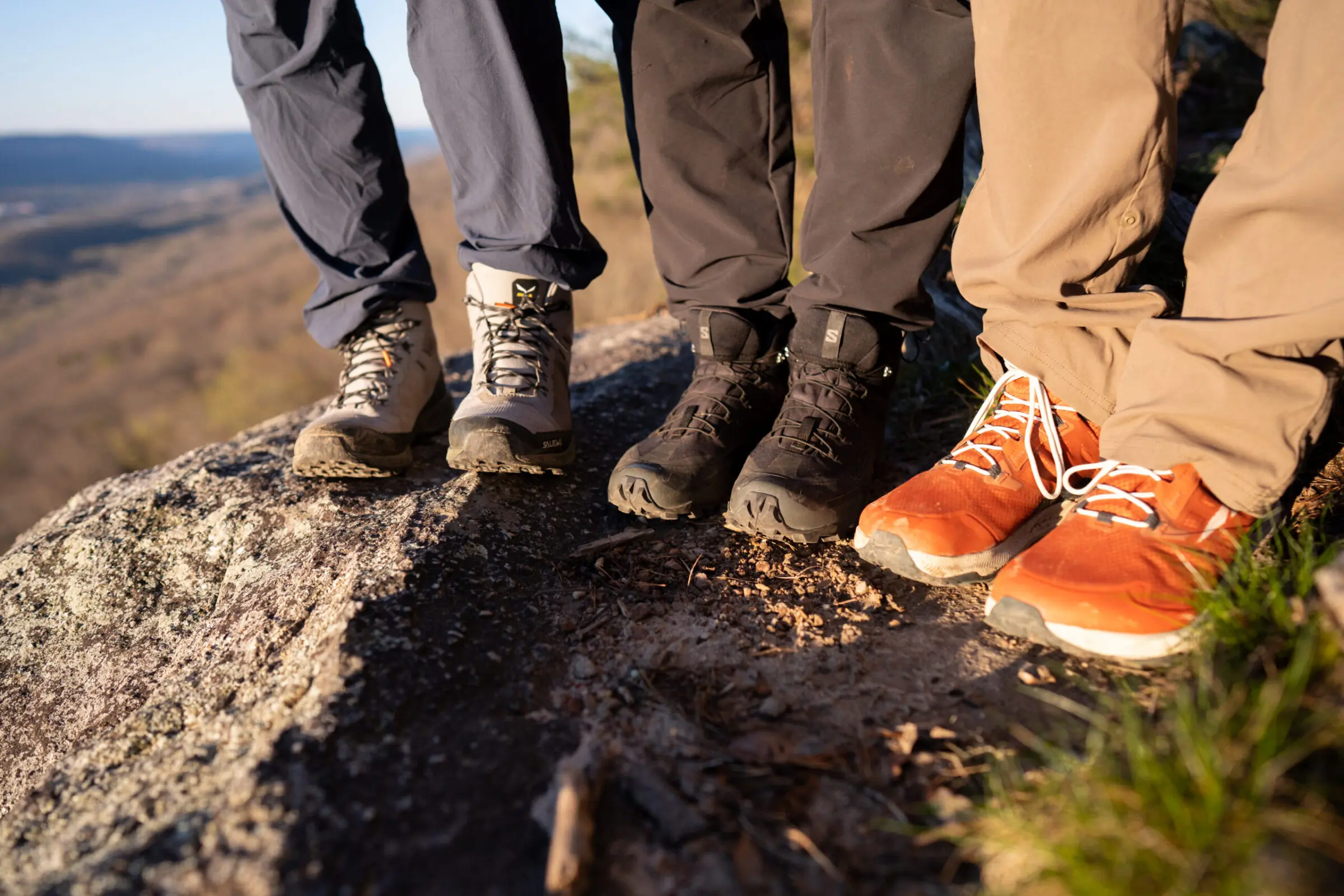

If you’re looking for the best hiking boots, look no further. We’ve tested dozens of hiking boots over hundreds of miles to help you stay happy and comfortable on the trail.


We tested and ranked the best hiking shoes for men and women for 2025, including top picks from Hoka, Salomon, Merrell, SCARPA, and more.
Read the full article here

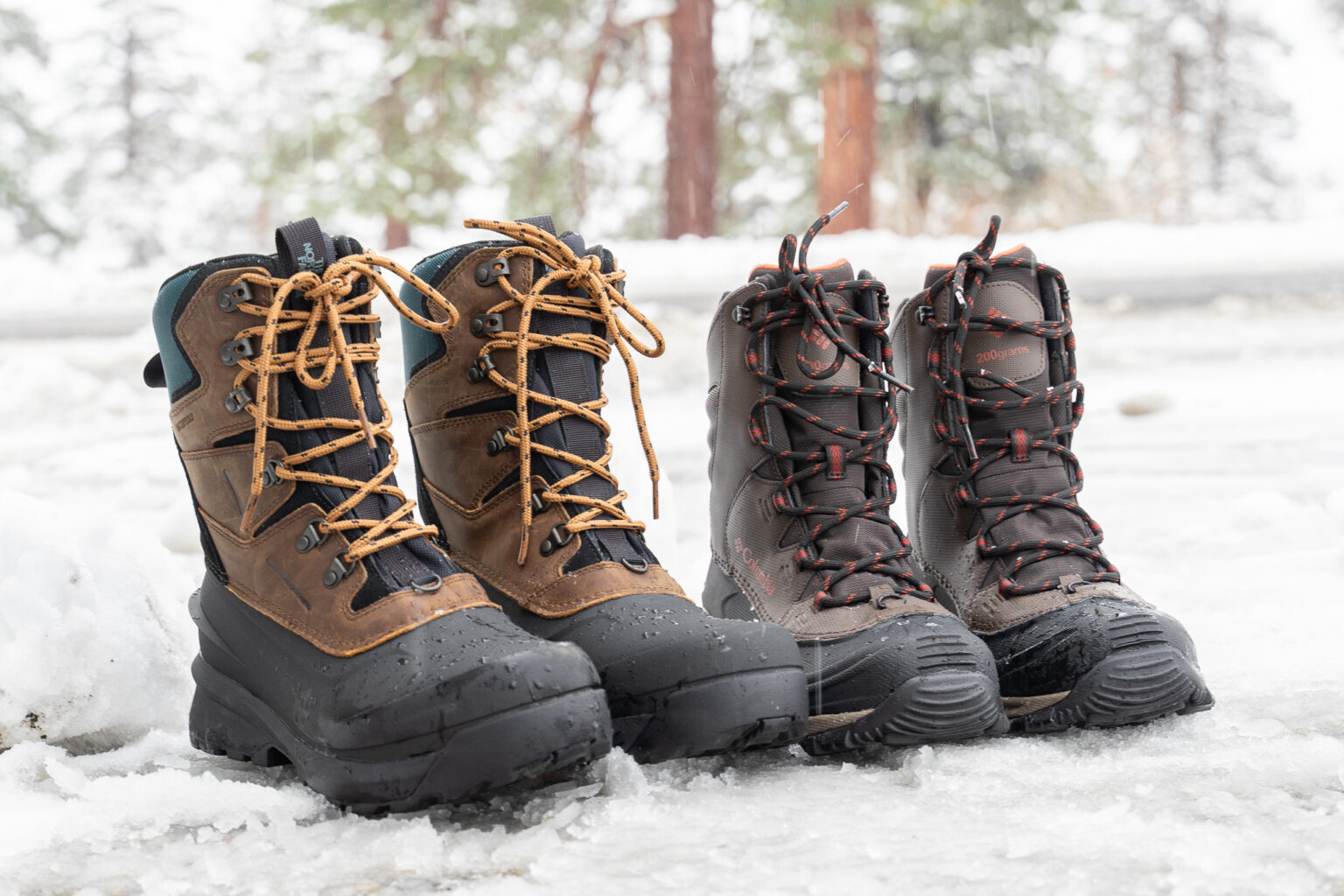
44 Comments
Exploration results look promising, but permitting will be the key risk.
Good point. Watching costs and grades closely.
Production mix shifting toward Tactical & Survival might help margins if metals stay firm.
Good point. Watching costs and grades closely.
Nice to see insider buying—usually a good signal in this space.
Good point. Watching costs and grades closely.
Production mix shifting toward Tactical & Survival might help margins if metals stay firm.
Good point. Watching costs and grades closely.
Good point. Watching costs and grades closely.
Exploration results look promising, but permitting will be the key risk.
Good point. Watching costs and grades closely.
Good point. Watching costs and grades closely.
Exploration results look promising, but permitting will be the key risk.
Good point. Watching costs and grades closely.
Exploration results look promising, but permitting will be the key risk.
Good point. Watching costs and grades closely.
Interesting update on The Best Winter Hiking Boots of 2025-2026. Curious how the grades will trend next quarter.
Interesting update on The Best Winter Hiking Boots of 2025-2026. Curious how the grades will trend next quarter.
Good point. Watching costs and grades closely.
Good point. Watching costs and grades closely.
I like the balance sheet here—less leverage than peers.
Good point. Watching costs and grades closely.
Exploration results look promising, but permitting will be the key risk.
Good point. Watching costs and grades closely.
Good point. Watching costs and grades closely.
I like the balance sheet here—less leverage than peers.
Good point. Watching costs and grades closely.
Good point. Watching costs and grades closely.
Silver leverage is strong here; beta cuts both ways though.
Production mix shifting toward Tactical & Survival might help margins if metals stay firm.
Good point. Watching costs and grades closely.
Exploration results look promising, but permitting will be the key risk.
Uranium names keep pushing higher—supply still tight into 2026.
Uranium names keep pushing higher—supply still tight into 2026.
Good point. Watching costs and grades closely.
Interesting update on The Best Winter Hiking Boots of 2025-2026. Curious how the grades will trend next quarter.
Good point. Watching costs and grades closely.
I like the balance sheet here—less leverage than peers.
Good point. Watching costs and grades closely.
If AISC keeps dropping, this becomes investable for me.
Silver leverage is strong here; beta cuts both ways though.
Good point. Watching costs and grades closely.
If AISC keeps dropping, this becomes investable for me.
Good point. Watching costs and grades closely.